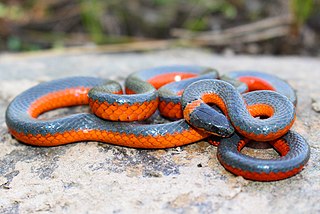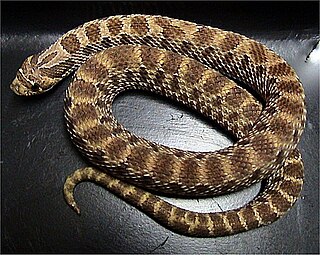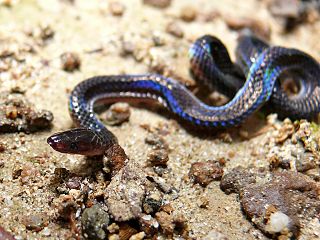
Pantherophis obsoletus, also known commonly as the western rat snake, black rat snake, pilot black snake, or simply black snake, is a nonvenomous species of snake in the family Colubridae. The species is native to central North America. There are no subspecies that are recognized as being valid. Its color variations include the Texas rat snake. Along with other snakes of the eastern United States, like the eastern indigo snake and the eastern racer, it is called “black snake”.

Garter snake is the common name for small to medium-sized snakes belonging to the genus Thamnophis in the family Colubridae. Native to North and Central America, species in the genus Thamnophis can be found in all of the lower 48 United States, and nearly all of the Canadian provinces south of the Northwest Territories and Nunavut—with the exception of Newfoundland and Labrador. They are found from the subarctic plains of west-central Canada east through Ontario and Quebec; from the Maritime Provinces and south to Florida, across the southern and central U.S. into the arid regions of the southwest and México, Guatemala and south to the neotropics and Costa Rica.

Diadophis punctatus, commonly known as the ring-necked snake or ringneck snake, is a harmless species of colubrid snake found throughout much of the United States, central Mexico, and south-eastern Canada. Ring-necked snakes are secretive, nocturnal snakes, so are rarely seen during the day time. They are best known for their unique defense posture of curling up their tails, exposing their bright red-orange posterior, ventral surface when threatened.
Karl Patterson Schmidt was an American herpetologist.

The western hognose snake is a species of snake in the family Colubridae. The species is endemic to North America. There are three subspecies that are recognized as being valid, including the nominotypical subspecies.
Telescopus hoogstraali, common names of which include Hoogstraal's cat snake and the Sinai cat snake, is an endangered cat snake species of the family Colubridae. The species is endemic to the Middle East.

Kirtland's snake is a threatened or endangered North American species of nonvenomous snake of the subfamily Natricinae, of the family Colubridae. It is the only species in the genus Clonophis.

The Caspian whipsnake also known as the large whipsnake, is a common species of whipsnake found in the Balkans and parts of Eastern Europe.

Ninia sebae, commonly known as the redback coffee snake or the red coffee snake, is a species of small terrestrial snake in the family Colubridae. The species is endemic to Mexico and Central America south to Costa Rica. Although it resembles some venomous coral snakes in color and size, it is not venomous and seldom bites humans.

Amphisbaena schmidti, known commonly as Schmidt's worm lizard or the Puerto Rican dusky worm lizard, is a species of amphisbaenian in the family Amphisbaenidae. The species is endemic to the Caribbean.

Lampropeltis mexicana, the Mexican kingsnake, is a colubrid snake that is endemic to Mexico.

Dolichophis jugularis, also known commonly as the black whipsnake and the large whip snake, is a species of snake in the family Colubridae. The species is native to West Asia. There are three subspecies.

Elaphe dione, commonly known as Dione's rat snake, the steppe rat snake, or the steppes rat snake, is a species of snake in the family Colubridae. The species is native to Asia and Eastern Europe. There are no subspecies that are recognized as being valid.

Calamaria schmidti, known commonly as Schmidt's reed snake, is a species of snake in the family Colubridae. The species is endemic to Malaysia.

Acanthodactylus schmidti, also known commonly as Schmidt's fringe-fingered lizard or Schmidt's fringe-toed lizard, is a species of lizard in the family Lacertidae. The species is endemic to Western Asia.
Peter Yulievich Schmidt was a Russian and Soviet zoologist, ichthyologist and museum curator.
Schmidt's helmet skink, also known commonly as Schmidt's crocodile skink, is a species of lizard in the family Scincidae. The species is endemic to Guadalcanal in the Solomon Islands.
Emoia schmidti, also known commonly as Schmidt's emo skink or Schmidt's skink, is a species of lizard in the family Scincidae. The species is endemic to the Solomon Islands.
Thrasops schmidti, Schmidt’s bold-eyed tree snake , is a species of snake of the family Colubridae.














